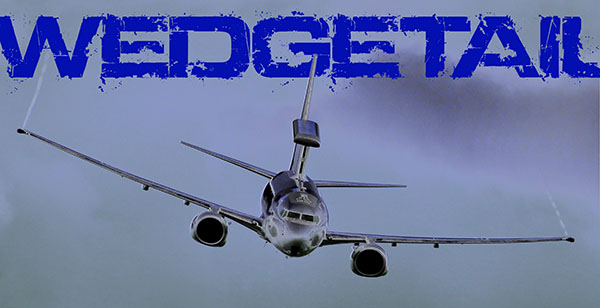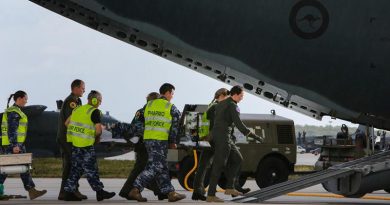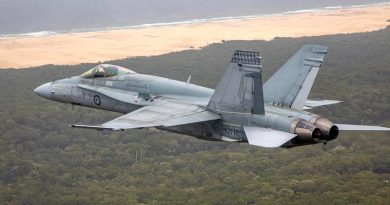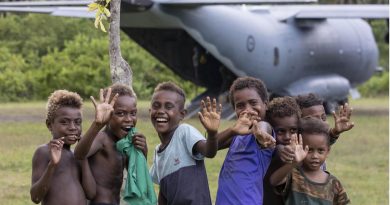When the ‘shit got real’ for Australia’s Wedgetail
Share the post "When the ‘shit got real’ for Australia’s Wedgetail"
Words Brian Hartigan
Photos ADF
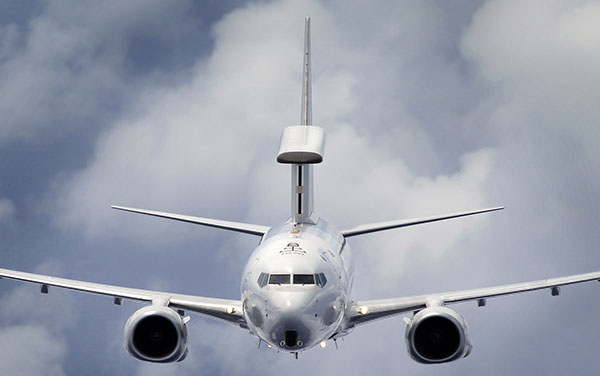
010411ZOCT14 was the exact moment that the ‘shit got real’ for callsign Magpie 01 – Australia’s E-7A Wedgetail airborne early warning and control aircraft – as it crossed the official line that separates the air war against ISIS from the rest of the world.
010411ZOCT14 …that’s 1 October 2014 at 4.11am UTC for those who need translation from the military date/time group – or 7.11am local
That first mission was supposed to be a fairly easy-paced shadowing of an American E-3 Sentry on station over the northern-Iraqi Battle Management Area (BMA), to allow the mission crew (using their own onboard callsign “Outback”) to observe how the job was done in real time before taking on any live tasking.
But when the ageing E-3 developed technical problems early in its mission, the Aussies stepped up and took over – throwing themselves and Australia’s newest and most advanced warplane headlong into the fight.
Back at Air Task Group Headquarters, RAAF Squadron Leader Glenn ‘Fish’ Salmon heard the call, “All stations, g’day. Outback has the BMA” – and callsign Outback began to prove itself to its coalition partners.
So successful has Australia’s Wedgetail now become that stories of American strike squadrons delaying or planning missions to coincide with Wedgetail flight times have filtered back to a proud Aussie hierarchy.
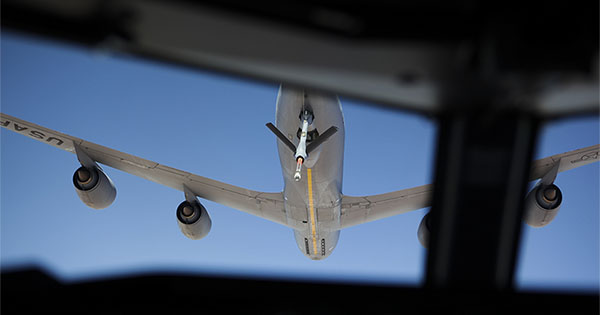
But it hasn’t all been plain sailing. Today’s success on Operation Okra was preceded by years of ridicule as a ‘project of concern’ and years of hard graft to turn the multi-billon-dollar project around.
So what is Wedgetail and how does it work?
Well to find out, I visited 2 Squadron at home on RAAF Base Williamtown recently – and had the extreme honour of becoming just the second journalist to fly on Wedgetail and the first to fly on an actual live training mission.
And I basically found out that much of what Wedgetail and its radar is capable of runs into those areas generally covered by, ‘if I told you I’d have to shoot you’…
What I can tell you is that the E-7A Wedgetail is based on a Boeing 737-700 Basic Business Jet (the same model as the PM’s VIP flight), with a few basic modifications to accommodate the fin-like multi-role electronically scanned array (MESA) radar it carries on its back – and literally tonnes of electronic wizardry inside.
Wedgetail has been a long time coming – and carries a significant weight of expectation.
Australia formally announced its desire to get into airborne early warning and control – a capability it did not have previously – in 1996.
Northrop Grumman was already developing the MESA radar at its own expense and talking to Boeing about a suitable platform to carry it.
The ubiquitous B737 was big enough to carry the 10.8m long by 3.4m high radar ‘fin’ and all the electronics that go with it – and the B737BBJ, with its extended-range fuel tanks (and an optional air-to-air refuel capability, which RAAF opted for) was ideal.
So then the RAAF came along, looking for a modern AEW&C capability that was capable enough for a physically-large country’s needs, but small enough to integrate into a relatively small air force.
So, soon after the turn of the new millennium, Boeing was awarded a contract for four aircraft with an option for three more. In the end, six were acquired.
The first two Wedgetails were assembled and tested in the USA with the final four assembled by Boeing in Australia.
Aircraft deliveries to the RAAF were initially scheduled to begin in 2006, but integrating the radar with sensor computer systems and software proved stubborn and significant program delays were encountered.
Eventually, however, the first two Wedgetails were delivered to the RAAF in November 2009 – three years behind schedule – but actually remained in Boeing ownership until May 2010.
The rest were progressively delivered until the sixth and final Wedgetail was handed over on 5 June 2012, with Initial Operational Capability declared in November the same year – just three short years ago.
In the interim, 2 Squadron has undertaken a massive program of exercises, building up from local training missions with RAAF Williamtown-based F/A-18s , to larger domestic exercises such as Aces North and Pitch Black, followed by Exercise Cope North in Guam, and eventually the much larger ‘Red Flag’ series of exercises in Nevada and Alaska.
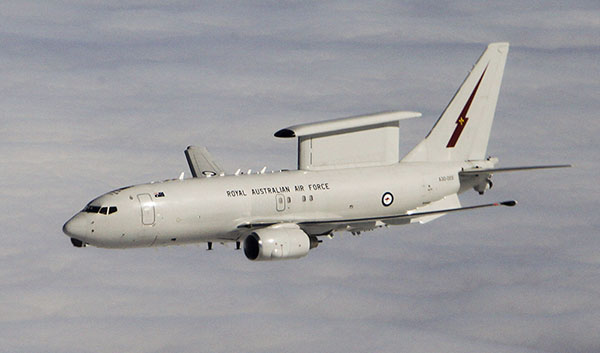
A typical Red Flag exercise involves a variety of attack, fighter and bomber aircraft (F-15E, F-16, F/A-18, A-10, B-1, B-2), air superiority aircraft (F-22, F-15C), airlift support (C-130, C-17), search and rescue aircraft (HH-60, HC-130, CH-47), aerial refueling aircraft (KC-130, KC-135, KC-10), command and control aircraft (E-3, E-8C, E-2C, Wedgetail), reconnaissance aircraft (Predator, Global Hawk, RC-135, U-2), electronic warfare aircraft (EC-130, EA-6B and F-16CJ), and ground-based command and control, space and cyber forces – and a full-time aggressor squadron playing enemy.
Red Flag is said to be the biggest, most complex air-warfare exercise in the world and as close to fighting a real war as an exercise can get.
Because of this escalating and intense program of exercises and despite its delayed introduction into RAAF service, Wedgetail and 2 Squadron were more than ready and willing when the callup for operations in Iraq was received late last year – and quick to prove the platform’s capability as a major strategic asset for Australia.
Wing Commander Paul Carpenter, who commanded Australia’s first Wedgetail detachment in the Middle East, says the value of all that training struck him when one young air combat officer paused during a mission brief for an Iraq sortie and said, “Red Flag standard, really…”.
“The youngest member of the crew in Iraq on that first rotation was just 22 years old and he was basically responsible for the whole northern sector of the Iraqi battlespace, talking to every fighter and tanker and doing all the organising of those assets in action,” Wing Commander Carpenter says.
“The senior guys on the crew were managing the plan, but the guy actually executing that plan, the guy actually talking to the other jets was someone in his early 20s, responsible for an enormous amount of airspace and an enormous amount of hardware and capability with enormous strategic implications.
“Obviously, one bomb dropped in the wrong place can have enormous political and national implications, so the personal responsibility associated with managing sensitive and critical information is really quite high.”
Wing Commander Carpenter says the people the RAAF needs to recruit to get the most out of Wedgetail – and the new P-8 Poseidon in the near future – need to be adaptable and comfortable working with uncertainty – working in the grey areas.
“We’re sending these young guys and girls into a very dynamic battlespace in the Middle East, a long way from home, on short notice to move, with all sorts of crazy things going on in Iraq and Syria.
“A new starter doesn’t need to know how to do the job the day he or she walks in the door, but they need a high capacity to learn and a personality to handle a lot of variables.
“To get the most out of a Wedgetail, the crew is processing an enormous amount of information in a digital environment and required to recognise what’s important, filter out the crap and act on that info in very very short cycles.
“There is a lot of initiative, resilience and mental capacity required – not to mention good looks.”
And most of the information coming to the air combat officers on Wedgetail comes from the MESA radar, which (in general, unclassified terms) is capable of simultaneous air and sea search to a maximum range of more than 600km.
Unlike a conventional rotating radar, MESA can look in any direction at any time, even shooting out beams of energy in multiple opposite directions – or it can concentrate its efforts in areas of interest, only returning occasionally to monitor ‘safe’ areas.
It can track up to 180 targets and conduct 24 simultaneous intercepts.
The aircraft also has an ESM (Electronic Support Measures) system, with a maximum range of 850km (depending on aircraft altitude), gathering location and type info on other radars as they transmit, or go quiet, to build up a ‘pattern-of-life’ picture for an area.
There are actually two major radar components in the fin atop the Wedgetail.
Side-emitting electronic manifold arrays provide 120° of radar coverage on either side of the aircraft, while the ‘top hat array’ fills in the remaining 60 degrees fore and aft, to give a full 360 degrees of coverage.
The cabin features 10 operator consoles with space for two more.
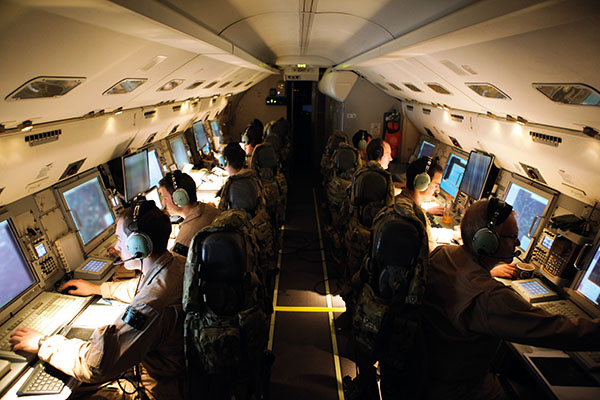
But operating the Wedgetail is not all about the good-looking aircrew. There’s a lot that goes on behind the scenes too.
Maintenance and flightline operations are pretty obvious enabling elements of any RAAF squadron and, in this regard, while 2 Squadron have attracted a highly rated ground crew, they are also blessed with owning a new jet, based on the most common of all commercial-jet platforms, which so far has given little in the way of mechanical trouble.
Other enablers include operations and logistics staff – all of whom do vital work in not only getting the aircraft off the ground, but making sure that when it arrives at a new location it and its crew can function, not just for one mission or the next, but for several weeks without major inputs.
This may sound simple or even like a throwaway line but, as a former aircraft mechanic, I can appreciate that literally years of planning and rehearsal and programming has obviously gone into ensuring that a jet of this size and complexity can sustainably deploy away from home for long periods.
Routine maintenance has to be forecast and the right spares and consumables loaded into space-critical flyaway kits.
As Wing Commander Carpenter says, mission-critical spares and supply chains may not be sexy subjects for media consumption, but without a lot of hard work and dedication from a lot people, Wedgetail would be little more than a very expensive and inefficient airliner.
And speaking of the media, Wing Commander Carpenter says that the secret status of much of its capability – and the complexity of what it actually does – makes it difficult to engage with the media.
It was nonetheless disappointing that Wedgetail didn’t get a lot of commercial media coverage out of Operation Okra.
“In terms of the operation over there, the main game is obviously dropping bombs and having kinetic effects against ISIL,” he says.
“So in that context, fighters are very easy to explain and understand in a short news article, and people are interested in that. Tankers too are pretty easy to understand and explain.
“But AEW&C is very hard to wrap up in 50 words or less.
“Do we distil it down and say we just control the airspace? I guess we could, but that doesn’t really do it justice.
“But to talk about what we do and what we are capable of doing without getting into classified areas and still tell the story of what we do is quite difficult.
“So it’s always going to be hard for us in the media space, and I guess we have to live with that.”
But for Wing Commander Carpenter there are two aspects of media coverage he is happy about – in the end.
“I have two news clippings from the same newspaper on my desk that relate to Wedgetail.
“One, from February 2009, says ‘ $3.8billion failure – disaster – Wedgetail is not performing to specifications and likely never will’.
“The other is from about the 4th of October last year, praising Wedgetail’s first operational mission in Iraq.
“That was the contrast after six years of enormous effort across the whole of team Wedgetail.
“That’s what we’ve achieved in just under six years – a $3.8billion project of concern transformed into a totally amazing capability that is sought after and requested by our coalition partners in the Middle East.”
FOOTNOTE: Just as we wrapped up this story, it was announced that Wedgetail has reached “Final Operational Capability” – FOC – which means, the fleet is now officially fully operational and able to support ongoing operations domestically and overseas. But it’s not just the aircraft – FOC also takes into account logistics, management, sustainment, facilities and training.
Well done everyone involved.
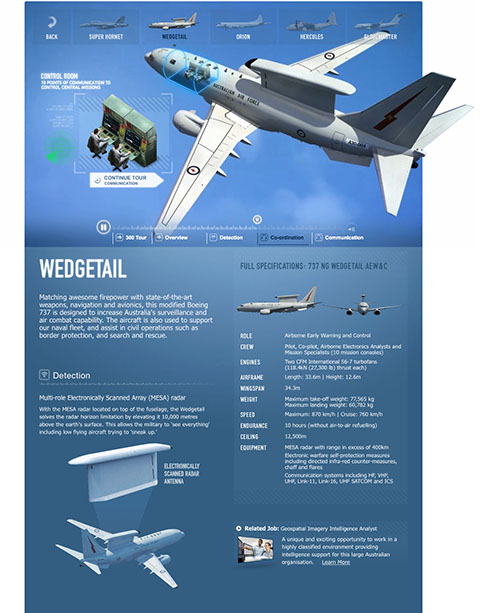
WORKSTATIONS:
Wedgetail’s 10 work stations are in the forward section of the aircraft, six on the port side and four to starboard.
They get most of their information from the distinctive dorsal-mounted radar antenna assembly, which incorporates side-emitting electronic manifold arrays in the vertical portion of the assembly and a ‘top hat’ array in the assembly’s horizontal cap. Between them, these providing 120° of radar coverage on each side of the aircraft. Other ‘top hat’ elements cover 60° fore and aft – for complete 360° coverage.
Radar signal processing equipment and central computers are installed in a separate cabin area directly below the antenna array.
AVIATION RECORD:
An Australian Wedgetail made history during the first rotation on Operation Okra when it set an impressive aviation record for the longest Australian command and control mission in a war zone.
Commander of Australia’s Air Task Group Air Commodore Steve Roberton said the endurance mission – 16 hours and 18 minutes – was a fine endorsement of Australia’s air power capabilities.
“After already being ‘on station’ for a number of hours, the Australian Wedgetail crew was advised that the Coalition aircraft due to relieve them was delayed,” Air Commodore Roberton said.
“In response, they quickly assessed their ability to coordinate necessary air-to-air refuelling and agreed to substantially extend their mission.”
In fact, the Wedgetail crew completed two air-to-air refuels during the record flight.
Air Commodore Roberton said the aircrew’s ability to ‘go above and beyond’ was a clear demonstration of Australia’s important contribution to the air campaign.
AIRCRAFT STATS:
| Length: | 110 ft 4 in (33.6m) |
| Wingspan: | 117 ft 2 in (35.8m) |
| Height: | 41 ft 2 in (12.5m) |
| Empty weight: | 102,750lb (46,606kg) |
| Payload: | 43,720lb (19,830kg) |
| Max takeoff weight: | 171,000lb (77,564kg) |
| Powerplant: | 2 × CFM International CFM56-7B27A turbofans |
| Power: | 27,000lbf (118kN) each |
| Cruise speed: | 530mph (853km/h) |
| Range: | 3500nm (6482km) |
| Endurance: | 10 hours without refuel |
| Endurance record: | 16 hours 18 minutes with 2 air-to-air refuels |
| Service ceiling: | 41,000ft (12,500m) |
| Crew: | 2 x pilots + 10 mission specialists |
| Protection: | EW self-protection, including directed infra-red counter-measures, chaff and flares |
| Communications: | HF, VHF, UHF, Link-11, Link-16, UHF SATCOM, ICS |
THE RADAR:
| MESA Radar: (multi-role electronically scanned array) | Northrop Grumman |
| 288 high-power transmit/receive modules | |
| operationally ready minutes after takeoff | |
| Wide area surveillance: | more than 340,000 square miles |
| Scan rate: | more than 30,000 square miles per second |
| typical 10-second scan rate (but, since scan rates are variable and sectors selectable, other coverage rates, ranges and priorities are programmable | |
| sector-selection modes provide three to four times higher target search rates and eight to 10 times higher track updates than rotating radars. |
- More videos and graphics are viewable in the magazine version of this story, published on 1 June 2015. Find it here.
- NOTE: The true capabilities of the MESA radar and other electronics aboard Wedgetail are classified. ‘Facts’ and figures quoted in this story were compiled from various Internet sources and were not supplied by 2 Sqn or Defence.
Feel free to share this story…
Share the post "When the ‘shit got real’ for Australia’s Wedgetail"

